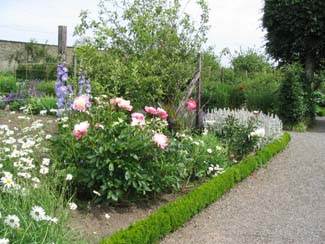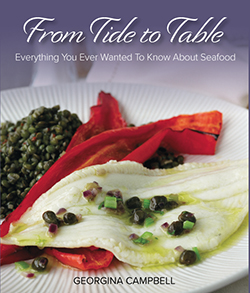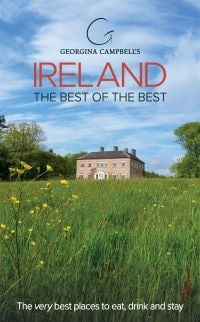Paperback edition of From Tide to Table - Everything You Ever Wanted To Know About Buying, Preparing & Cooking Fish and Seafood
by Georgina Campbell
Co. Kildare CARBURY
Ballindoolin House & Garden
 The gardens at Ballindoolin are a shining example of what can be achieved with buckets of imagination and hard work, plus some help from EU friends. When the Molony family inherited Ballindoolin estate in 1993 little remained in the large walled garden behind the 1821 house except for some venerable espaliered apple trees.
The gardens at Ballindoolin are a shining example of what can be achieved with buckets of imagination and hard work, plus some help from EU friends. When the Molony family inherited Ballindoolin estate in 1993 little remained in the large walled garden behind the 1821 house except for some venerable espaliered apple trees. Its restoration was carried out in 1997 with the help of the Great Gardens Restoration Scheme, to a design by Daphne Shackleton. A JCB was used to clear the jungle, uncovering a melon pit and original paths in the process, and the ground was ploughed before replanting began.
Now the garden looks much as it would have done in its heyday. There are 100 foot herbaceous borders with gold and white predominating, a lavender path running down the central axis of the garden, and a grid of paths delineating different areas for vegetables, fruit and new espaliered fruit trees, plus a curious whirling patterned parterre based on the original design.
Every bit as appealing are the woodland walks and displays of spring bulbs and flowering shrubs. There is a nature trail with curiosities like an iron age mound, and a lime kiln and the opportunity learn the Celtic lore of the trees which divided trees into chieftans and commons.
There is a tour of the ground floor of the house and also a museum, a coffee shop and a gift shop - and you can rest assured that fruit from the garden makes the most delicious home made jam, which is on sale in the shop.
Williamstown Garden
 If ever there is a place with an enchanted fairytale atmosphere it is the original 18th century beech walk at Williamstown. Seen through its twilit aisle of contorted branches a path, bordered with clouds of blue nepeta and leading to a blaze of scarlet plants, appears like a brilliant vision. This is the heart the old walled garden adjoining a Palladian house attributed to Nathaniel Clements, dating to 1760 and set in a 700 acre estate. Set within the old framework and ancient trees the garden was restored in 2000, its walls repaired, room like compartments created and borders reinstated.
If ever there is a place with an enchanted fairytale atmosphere it is the original 18th century beech walk at Williamstown. Seen through its twilit aisle of contorted branches a path, bordered with clouds of blue nepeta and leading to a blaze of scarlet plants, appears like a brilliant vision. This is the heart the old walled garden adjoining a Palladian house attributed to Nathaniel Clements, dating to 1760 and set in a 700 acre estate. Set within the old framework and ancient trees the garden was restored in 2000, its walls repaired, room like compartments created and borders reinstated. The entrance to the garden leads through a charming 18th century potting yard to a garden of meditation laid out with a ‘Path of Life’. With displays of hellebores, snowdrops, ivies and ferns, the play of sunlight through trees and the burble of a water tree fountain it’s a place to soothe the senses. The double herbaceous border, which forms the axis of the garden, looks for all the world like an Edwardian watercolour. One of Gertrude Jekyll’s favourite palettes, blues, white, silver and soft yellows - predominate with clumps of lemon Primula florindae, Anthemis tinctoria, krigishoma, agapanthus, tradescantia and tree paeonies.
There is a vista to a sundial which marks one of the characteristic changes of mood, in one direction there is the gothic gloom of the beech tunnel, in the other is a bee border of cat mint and pink hardy geraniums. Beyond the sundial the double border continues in still paler shades to two clumps of gunnera marking the entrance to a hidden green area. Here extraordinary beech arches, fused 200 years ago, appear like Tolkeinesque monsters.
Other treats include an exquisite temple, its rounded Palladian arches echoed by the patterns of two meticulous box parterres each containing 1,000 plants, hot borders, a woodland spring garden, a model potager with cardoons, sunflowers fruit and vegetables with onions planted around circles of carrots to confuse the carrot fly. And, in a former deer park, grass paths lead among contented cattle through a young arboretum to inviting seats.
Carbury Free Range Chicken
Nurney Organic Farm
Show me all Co. Kildare



